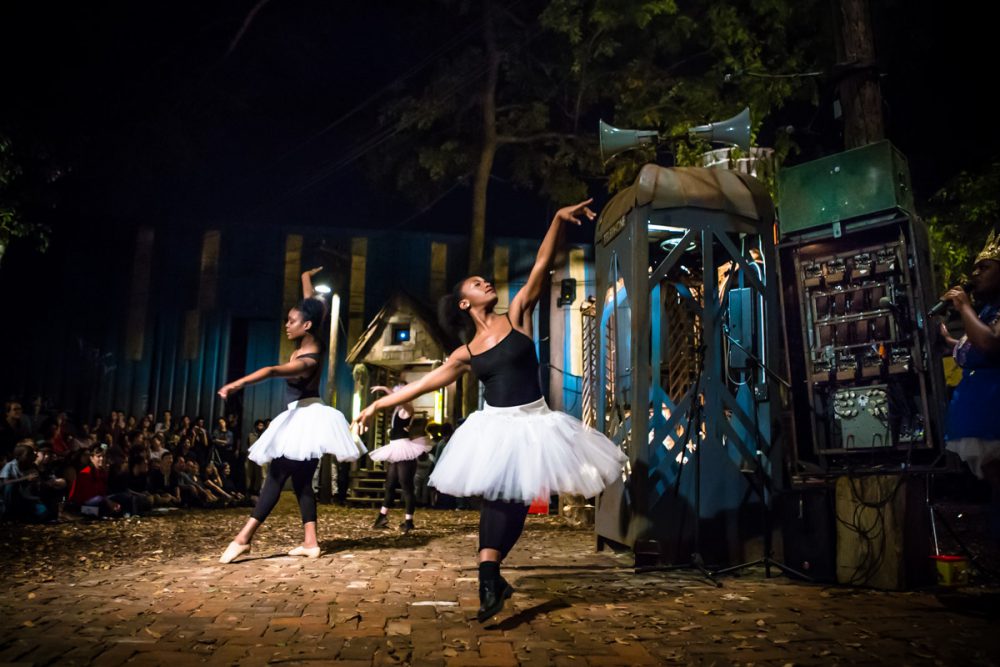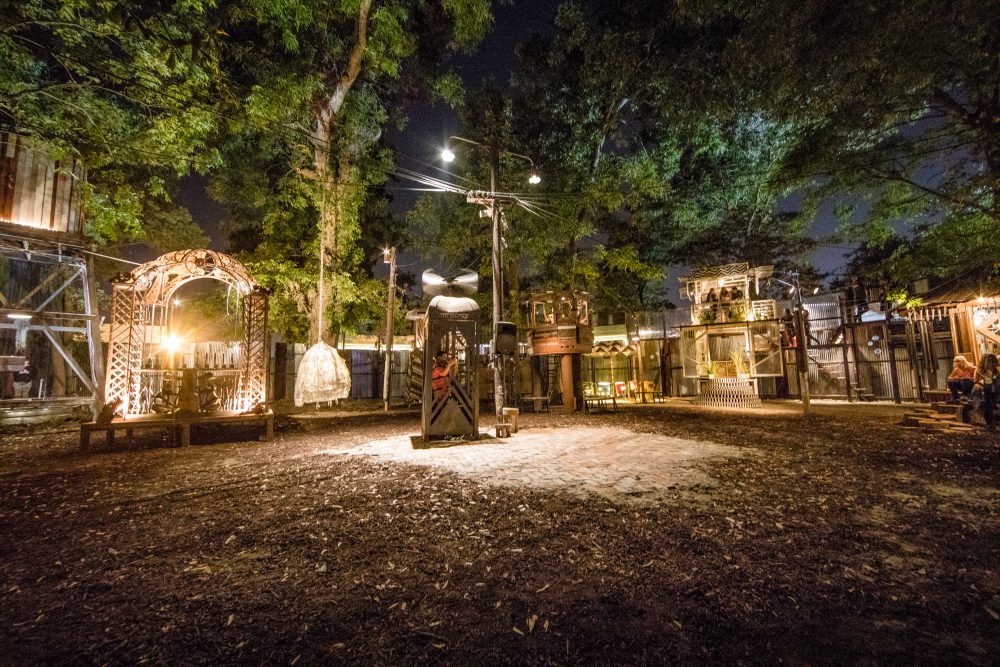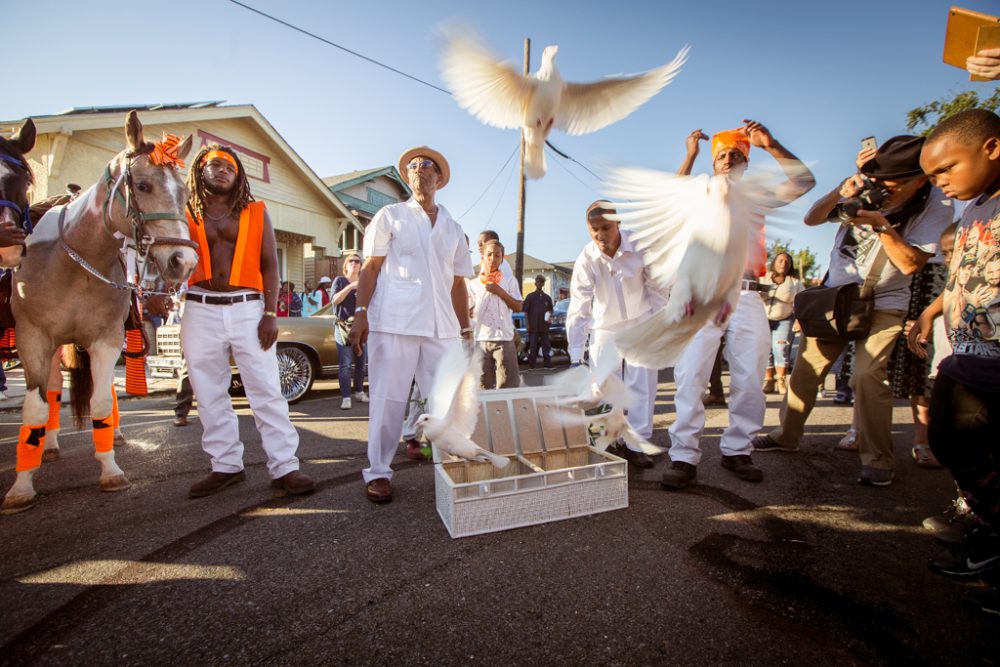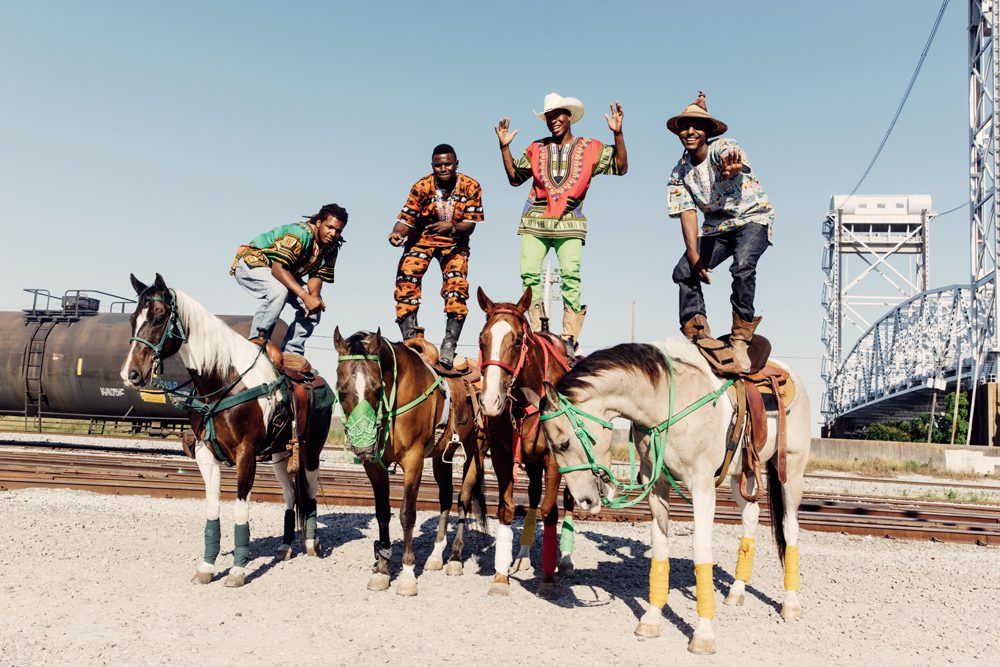Perpetual Evolution: An Interview with Delaney Martin
Curator Claire Tancons talks to Delaney Martin of New Orleans Airlift about the Music Box Village’s permanent home, an upcoming project on Lake Pontchartrain, and the ethics of creating art in New Orleans.

Dancers in a 2016 performance directed by Tank and the Bangas at the Music Box Village, New Orleans. Courtesy New Orleans Airlift.
Editor's Note
In fall 2016, New Orleans Airlift inaugurated the permanent location of its Music Box Village. Previously a roving initiative—setting up camp adjacent to an old Creole cottage in the Bywater, in City Park, and in cities around the world—the Music Box aims to bring “musical architecture” to the masses through artist-designed houses-turned-instruments. In its various incarnations, the Music Box has been activated by musicians including Wilco, Solange Knowles, the Preservation Hall Jazz Band, the Lost Bayou Ramblers, and Gogol Bordello. The Music Box is only one of New Orleans Airlift’s many initiatives to promote collaboration between artists and communities in New Orleans and beyond.
In advance of New Water Music, a collaboration with the Louisiana Philharmonic Orchestra, curator Claire Tancons talks with New Orleans Airlift co-founder Delaney Martin about the organization’s development since its founding in 2008.
Claire Tancons: You founded New Orleans Airlift with Jay Pennington over eight years ago as an international exchange program for the New Orleans artistic community in the aftermath of Hurricane Katrina to bring New Orleans to the world and the world to New Orleans. How does it feel to have planted more permanent roots in the city with the recently opened Music Box Village? How has New Orleans Airlift’s mandate evolved since its earlier, traveling days?
Delaney Martin: What started as a stop-gap series of projects post-storm to help out a bunch of folks, from sissy-bounce rappers to Bywater puppeteers, has evolved over time to be an art practice. We realized that helping a community of people we wanted to see celebrated in New Orleans and beyond was extremely satisfying, but we also had to square it away with our own needs as artists. Jay is a musician and I had been doing large-scale installations for years when we first started Airlift.
This need led us to creating what has become the standard for Airlift projects. We collaborate with the artists we love by devising our own artistic frameworks and then inviting folks in to work within the parameters of those projects. I remember when I first invited artists to be part of the Music Box, I was very clear with everyone that this would not be a group show, but an effort on all parts to make a harmonious village of unique voices working towards a whole that was bigger than any one of us. It is a form of collaboration that is radical in its scale and its levels of trust, exchange, and support for one another. Other projects like Rally Under the Bridge, Upstairs at the Wax Museum, and Public Practice, two of which you worked with us on, all have this framework.
So to now have this mode of working be permanently affixed to the landscape of New Orleans in the form of the Music Box Village—to have it exist as a living artwork with a perpetual evolution through the ebb and flow of ideas and identities—is very exciting because permanence for us does not actually mean a fixed state. And that is something we feel very comfortable with.
CT: The new permanent home for the Music Box Village, Airlift’s previously roaming, flagship project, is located where North Rampart Street meets the levee, right by the Industrial Canal. How does the proximity to the very geography that wreaked havoc on New Orleans during Hurricane Katrina inform your work nearby and Airlift’s cultural ecosystem?
DM: To live in New Orleans, to invest time, money, energy, and passions in this place, is and has always been a precarious proposition—for anyone. Our proximity to the Industrial Canal and Mississippi River of course reminds us of the power of nature to upend lives, but, possibly more strongly, it situates our feelings about community. This body of water flooded the Lower Ninth Ward. We are in the Upper Ninth Ward. Even as people are still trying to rebuild their homes and churches ten years later in the Lower Ninth Ward, another form of displacement is creeping in—in the form of new, white, and wealthier residents, many of whom are our friends and artistic collaborators. They are pushing out other largely black communities, also friends and artistic collaborators, many of whom represent the heritage and street culture that Airlift has celebrated in much of our work. The flow of people, like the flow of water, can upend lives and cultures. So as we sit at the base of the bridge over this particularly potent waterway, we spend a lot of time struggling to know what to do, questioning our place and our role in supporting culture, creating culture, overexposing culture, and displacing culture—and simply asking whose culture and what and why.

New Orleans Airlift’s Music Box Village in New Orleans. Courtesy New Orleans Airlift.
CT: Can you tell me more about Airlift’s upcoming collaboration with the Louisiana Philharmonic Orchestra (LPO)? How do you plan to amplify water and music, to draw out their mutual potentials as foundational natural and cultural phenomena, particularly in the city of New Orleans, which bathes in both?
DM: We were honored to be asked by the celebrated contemporary composer Yotam Haber to join and help create his vision for New Water Music. His piece is based on George Frideric Handel’s Water Music of 1717 that was famously performed on the River Thames and notable also for bringing classical music, no less by one of the most important composers of the day, to the hoi polloi of London, as opposed to exclusively aristocratic audiences. Yotam was keeping these qualities and adding to it a siren call for the environmental state of coastal Louisiana and for other communities the world over facing water-related issues that are displacing lives and cultures and altering their geographic landscapes.
Yotam asked us to create the boats and visual environment for the piece. I have taken the lead on this work, first moving the project from the proposed location of Bayou St. John, which felt very tame and is also a site that would not reach broader audiences, to the outlet of the Industrial Canal into Lake Pontchartrain at Seabrook Boat Launch. This is a well-used site by fishermen and bathers from the Gentilly and New Orleans East communities. The structure of the Industrial Canal speaks to human agency and interference, while the vastness of the lake’s stretching surface speaks to the sublime and awesome power of nature.
I also decided to put the visual direction in the hands of the communities most directly affected by the issues this project raises—fishermen, their families, and voices from coastal communities. We will be creating a presentation in which fishing vessels play a large role. Our visual direction is also informed by the traditions of the coast, namely the blessing of the boats, in which families decorate their boats and get them blessed at the start of the fishing seasons.
I love the journeys that create the relationships with the people we work with. And working with fishermen makes sense because the heart of our work is seeking to build bridges across communities by involving them in a process that honors who they are while inviting them to be part of something that is bigger than any one part. So to have the LPO and fishermen come together is special. We are also working with the Gentilly and New Orleans East communities to flesh out the interconnection of our reliance on the state of the water by creating performative projects around food that will take place on the water and on land. Then there are all the organizations, agencies, and individuals who have opinions and stakes in these issues, and they have a role in this too! There are a lot of components and part of our fun (and our challenge) is bringing them all together in a meaningful way where everyone feels heard, felt, and seen. We won’t be solving a crisis with this project, but we will be creating a context that allows for exchange in a disarming way that could have repercussions for good.

New Orleans Airlift’s Public Practice: An Anti-Violence Community Ceremony, 2014, under the artistic direction of Delaney Martin and Claire Tancons in New Orleans. Courtesy New Orleans Airlift.
CT: Is it correct to assume that Airlift’s ethics of collaboration, of which the LPO project you just described provides a stellar example, extends beyond the relationships formed and the projects created and that it also helps feed back into the organization’s financial sustainability and operational viability?
DM: Without question. New Water Music is being funded by us, the LPO, and Yotam. We are all out hustling! But there is also tremendous in-kind support coming from the coastal organizations in terms of outreach and by vendors who are providing everything from the barge to maritime industrial materials like giant buoys and fenders. For instance, we are getting a great deal on our water-safety personnel who felt invited into the project as collaborators, as opposed to hired for the day, and who are going so far as to agree to wear costumes as long as they don't interfere with their safety gear! On the other hand, while we are paying every fisherman and vessel for participation, it is incredibly important that they also do not feel like boats for hire, but collaborators. As I think you once said to me, Claire, collaboration is an incredible tool when it is real and folks are able to leave egos at the door and really dig in.
CT: You have spoken to me about the agonizing process of crowdfunding and grant writing—even as you have been very successful at both—and the challenge of accepting grants and donations from corporate sponsors whose activities endanger the region’s natural ecosystem, its coastal waterways specifically. In the wake of President Obama’s activation of the Outer Continental Shelf Lands Acts, how does Airlift navigate such troubled waters?
DM: As we talk about ecological and cultural ecosystems, it is also important to tie in the financial ecosystem, which is often the driver of changes within these other interconnected spheres. At our New Water Music event, there will be a time for dialogue where we will hear from environmentalists, fishermen, wetlands cattle ranchers, and hopefully from people employed by the oil industry, because they are all stakeholders and part of what they are holding on to is their financial livelihoods.
But artists and arts organizations operating in New Orleans are equally tied to this ecosystem. Something even as innocuous sounding as a Jazz and Heritage Foundation grant is, at the end of the day, in large part backed by Shell Oil, who sponsors Jazz Fest which is “our culture,” right? It’s complicated. In the past, Airlift has had brushes with corporate money, but it was actually foundation money that was supported directly by oil that raised the largest battle cry amongst some of our constituents who lovingly believe in Airlift as a utopian, idealist organization. We are in fact a Modernist project that believes we can change the world in however small a way, but the reality is that it is incredibly difficult to work in the arts in New Orleans and practice ethical fundraising. All money is dirty money.
Saying that, New Water Music does not have any oil money attached to it—that we know of—and is being generously funded in large part by the MAP Fund, a wonderful and prestigious organization in New York. But if we dug deep, there is likely something egregious about the origins of MAP Fund’s money via their backers and so on. So I think the point is not to make accusations about who is ethical and who is not in a survivalist non-profit economy but to try to understand the systemic problems and address them with honesty.

The 504 Boyz Horse Club in New Orleans Airlift’s Rally Under The Bridge, 2014, under the artistic direction of Delaney Martin and Claire Tancons in New Orleans. Courtesy New Orleans Airlift.
CT: To go back to thinking about water, in Masses and Power, his 1960 book with wide-ranging social and political implications about the nature of people and power, Elias Canetti writes of rivers as metaphors of the processional character of crowds. How does this image awaken your imagination in terms of thinking about New Orleans’ processional culture and our own processional projects?
DM: It is a daunting image because I just see so many generations washing by us. With respect to the environment and its effect on livelihoods and the cultures they produce it is scary that there are stubborn forces, much like the power of a crowd, which still refuse to switch course. This incoming administration is terrifying on so many counts, but environmentally it is absolutely apocalyptic in the face of science and reason.
But when I think of New Orleans’ processional culture, I feel the river metaphor more gently: Procession here, for me, is working it out it in the streets. Working out anger, working out joy, working out boredom, working out pride, working out tradition and innovation. And I see some of our processional projects, Rally Under the Bridge and Public Practice, that we have created together alongside our collaborators, as an attempt to use this meandering form that New Orleans culture has long partaken of as a way to have new feelings about the world and each other.
Editor's Note
Delaney Martin’s “Siren Song: A Prelude to New Water Music,” featuring Yotam Haber’s A Wine Dark Sea is on view through February 4, 2017, at Barrister’s Gallery (2331 St. Claude Avenue) in New Orleans. New Water Music, a free public performance on Lake Pontchartrain, will take place on April 8, 2017. Ticketing information will soon be available on New Orleans Airlift’s website.



